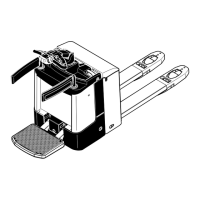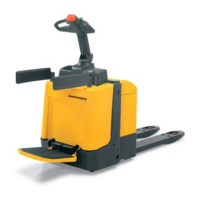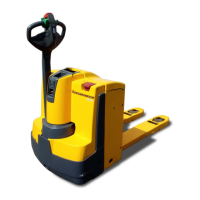03.13 EN
18
7 Electrolyte circulation
7.1 Functional Description
Electrolyte circulation ensures the supply of air during charging to mix the electrolyte,
thereby preventing any acid layer, shortening the charge time (charge factor approx.
1.07) and reducing the formation of gas during charging. The charger must be
suitable for the battery and electrolyte circulation.
A pump in the charger produces the necessary compressed air which is introduced
to the battery cells via a hose system. The electrolyte is circulated via the inlet air and
the electrolyte density level is constant over the entire length of the electrode.
Pump
In the event of a fault, e.g. if the pressure control system responds for an unknown
reason, the filters must be checked and replaced if necessary.
Battery connection
A hose is attached to the pump module which together with the charge leads is routed
from the charger to the charging connector. The air is passed on to the battery via the
electrolyte circulation coupling ducts in the connector. When routing make sure the
hose is not bent.
Pressure monitoring module
The electrolyte circulation pump is activated when charging begins. The pressure
monitoring module monitors the build up of pressure during charging. This ensures
that the required air pressure is provided for electrolyte circulation charging.
In the event of malfunctions such as:
– Battery air coupling not connected to circulation module (if coupling is separate) or
faulty.
– Leaky or faulty hose connections on battery or
– Intake filter contaminated
a visual error message appears on the charger.
03.13 EN
18
7 Electrolyte circulation
7.1 Functional Description
Electrolyte circulation ensures the supply of air during charging to mix the electrolyte,
thereby preventing any acid layer, shortening the charge time (charge factor approx.
1.07) and reducing the formation of gas during charging. The charger must be
suitable for the battery and electrolyte circulation.
A pump in the charger produces the necessary compressed air which is introduced
to the battery cells via a hose system. The electrolyte is circulated via the inlet air and
the electrolyte density level is constant over the entire length of the electrode.
Pump
In the event of a fault, e.g. if the pressure control system responds for an unknown
reason, the filters must be checked and replaced if necessary.
Battery connection
A hose is attached to the pump module which together with the charge leads is routed
from the charger to the charging connector. The air is passed on to the battery via the
electrolyte circulation coupling ducts in the connector. When routing make sure the
hose is not bent.
Pressure monitoring module
The electrolyte circulation pump is activated when charging begins. The pressure
monitoring module monitors the build up of pressure during charging. This ensures
that the required air pressure is provided for electrolyte circulation charging.
In the event of malfunctions such as:
– Battery air coupling not connected to circulation module (if coupling is separate) or
faulty.
– Leaky or faulty hose connections on battery or
– Intake filter contaminated
a visual error message appears on the charger.

